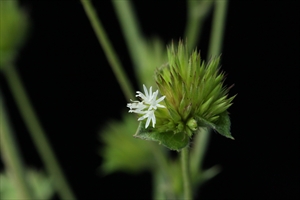- Widespread. Asia, Africa, North, South and Central America, Caribbean, Oceania. In many Pacific islands.
- Aggressive perennial weed of plantations, forming dense stands in sunny, dry, disturbed places, in pastures, where rainfall moderate to high, and threat to native species. Seeds prolifically and leaves of young plants produce thick ground cover smothering competitive species. Cattle do not eat it.
- Fast-growing, up to 1.5 m tall. Forms rosette of leaves, each up to 30 cm long, underside sticky and covered with hairs. One or more branched, flowering stems with smaller, alternate leaves, toothed margins, and winged leaf stalks. Flowerheads white flowerheads up to 2 cm wide, in clusters. Seeds black with bristles.
- Spread: seeds, by fur of animals, clothing, wind; contaminant of pasture seeds; perhaps for medicine and as ornamental.
- Biosecurity: Among 10 most important weeds of Vanuatu. On Global Invasive Species Database of alien invasive species (IUCN, 2020). Noxious weed in Fiji.
- Biocontrol: Fly, Tetreuaresta obscuriventris, introduced to Fiji and Hawaii. Little impact.
- Cultural control: Hoeing; mowing (plus herbicide); plough, disc and harrow; vehicle hygiene.
- Chemical control: in Australia: fluroxypy; glyphosate; triclopyr + picloram; metsulfuron-methy; picloram. Elsewhere, glyphosate or MCPA (Fiji); 2,4-D.







